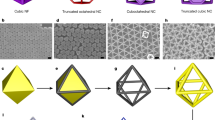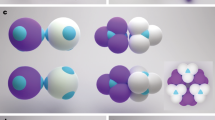Abstract
Colloidal crystals are ordered arrays of particles in the nanometre-to-micrometre size range. Useful microstructured materials can be created by replicating colloidal crystals in a durable matrix that preserves their key feature of long-range periodic structure1. For example, colloidal crystals have been used to fabricate structures from inorganic oxides1,2,3,4,5, polymers6,7, diamond and glassy carbon8, and semiconductor quantum dots9, and some structures have photonic properties4,8,9 or are patterned on different hierarchical length scales5. By using colloidal crystals as templates, we have synthesized a new class of metallic materials with long-range nano-scale ordering and hierarchical porosity.
Similar content being viewed by others
Main
We formed porous metallic nanostructures by using colloidal crystal templates from monodisperse, negatively charged polystyrene latex microspheres 300 nm to 1 μm across. The close-packed crystals were assembled by filtration1,3 through a smooth polycarbonate membrane with pores (50 nm) that retained the latex and the gold particles but allowed a high flux of water. The diluted latex particles were slowly deposited into densely packed layers about 35 μm thick. Colloidal gold particles 15–25 nm across were then slowly deposited in the interstices of the latex crystals by filtration, forming a mesoporous structure around the latex microspheres. This porosity allowed the solvent to flow through the deposit until the pores were filled by the gold colloid. Because of diffraction, the dried latex–gold flakes generate strongly coloured reflections that are much brighter than those of the original latex templates alone (Fig. 1a, b).
The three different procedures we used to remove the latex beads from within the composite yielded porous metal with different properties. Calcination for 30 min at 300 °C yielded flakes with the colour of metallic gold, but with multicoloured domains on the surface (Fig. 1c). Removing the latex templates at room temperature by oxidation with acid or by dissolving in trichloromethane gave brown flakes with brightly coloured reflections. All the samples were conductive, with resistance higher than, but of the same order of magnitude as, that of metallic gold foil.
Scanning and transmission electron microscopy revealed that the materials have a three-dimensional structure of ordered pores throughout the flakes (Fig. 2a). As in previous observations1, monocrystalline hexagonal domains of up to a thousand identical pores are predominant on the surface, usually corresponding to three-dimensional, randomly stacked, hexagonal close-packed planes and face-centred cubic packing (Fig. 2b,c), although square arrays are occasionally seen. The lattice dimensions correspond to those of the original latex crystals, indicating that there was negligible shrinkage of the metallic structure, in contrast to that seen for inorganic oxides1,2,3,4.
a, Side view of the flake, showing long-ranged ordered arrays of pores, both on the surface and through the flake. b, A typical area on the surface of a calcined sample, showing fusion, domain boundaries and crystal defects. c, A sample obtained by latex dissolution. d, Transmission electron micrograph at the edge of a flake obtained by dissolution, showing the mesoporous particulate gold structure.
The materials formed by calcination are macroporous, with a smooth, fused gold structure (Fig. 2b). In contrast, the solvent dissolution method preserves the original particulate gold structure around the large pores (Fig. 2d). In this mesoporous–macroporous material, the size of the small pores and the overall surface area are determined by the size of the gold particles. Materials with such controlled hierarchical porosity may be particularly suitable for catalytic applications, as they provide a combination of efficient transport and high surface area.
The lace-like structure of the flakes (Fig. 2c) is an almost exact replica of some three-dimensional wire-mesh photonic crystals10, but reduced by a factor of 20,000 to the sub-micrometre scale. The materials may therefore have photonic properties in reflectance mode in the visible-light region. In principle, the method can be improved to allow the formation of layers only a few pores thick, with interesting transmission properties. The simple ‘wet’ method can also be adapted to create materials from other metals, alternating layers of metals, or composite metallic–dielectric structures. Such new materials could be used in advanced catalysis or electro-optical devices, as well as in reflective, conductive or energy-collecting metallic coatings.
References
Velev, O. D. et al. Nature 389, 447–448 (1997).
Imhof, A. & Pine, D. J. Nature 389, 948–951 (1997).
Holland, B. T., Blanford, C. F. & Stein, A. Science 281, 538–540 (1998).
Wijnhoven, J. E. G. J. & Vos, W. L. Science 281, 802–804 (1998).
Yang, P. et al. Science 282, 2244–2246 (1998).
Park, S. H. & Xia, Y. N. Chem. Mater. 10, 1745–1747 (1998).
Johnson, S. A., Ollivier, P. J. & Mallouk, T. E. Science 283, 963–965 (1999).
Zakhidov, A. A. et al. Science 282, 897–901 (1998).
Vlasov, Y. A., Yao, N. & Norris, D. J. Adv. Mater. 11, 165–169 (1999).
Sievenpiper, D. F., Sickmiller, M. E. & Yablonovitch, E. Phys. Rev. Lett. 76, 2480–2483 (1996).
Author information
Authors and Affiliations
Corresponding author
Rights and permissions
About this article
Cite this article
Velev, O., Tessier, P., Lenhoff, A. et al. A class of porous metallic nanostructures. Nature 401, 548 (1999). https://doi.org/10.1038/44065
Issue Date:
DOI: https://doi.org/10.1038/44065
This article is cited by
-
Freeze-derived heterogeneous structural color films
Nature Communications (2022)
-
Relationship between red blood cell aggregation and dextran molecular mass
Scientific Reports (2022)
-
Lifting restrictions on coherence loss when characterizing non-transparent hypersonic phononic crystals
Scientific Reports (2021)
-
Morphology and electric potential-induced mechanical behavior of metallic porous nanostructures
Friction (2020)
-
Sponge-like nanoporous single crystals of gold
Nature Communications (2015)
Comments
By submitting a comment you agree to abide by our Terms and Community Guidelines. If you find something abusive or that does not comply with our terms or guidelines please flag it as inappropriate.





